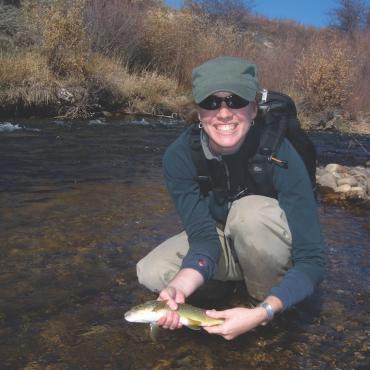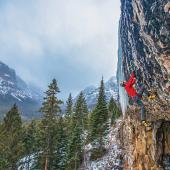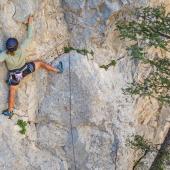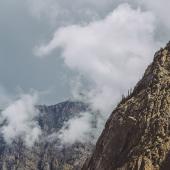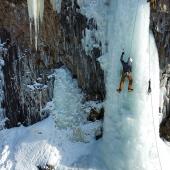For Every Climb, There Is a Season
Every devout ice climber knows that autumn brings more than just golden aspens and pumpkin-carving. After the first frost hits you can pick “them” out, poking around drainage and falls around Hyalite, beaming like children on Christmas morning as the first few icicles begin forming. And every hardcore rock climber knows that even though white shoes are no longer fashionable after Labor Day, your chalk bag has a place of prominence in your closet year-round.
Montana is a cornucopia of climbing, no matter what your diet may consist of. With the warm and wet Indian summers we’ve been enjoying the last few years, fall climbing can’t be beat, and ice and rock ascents intermingle depending on your mood. In early November a couple years ago, I spent a warm, 70-degree day dancing up the graceful spine of the Dragon’s Back near Butte, and the following day was introduced to my first magical icefall in Hyalite Canyon. Southwest Montana holds a variety of different climates, so you can always find a venue to satisfy any passion.
Rock
Dozens of choices exist within an hour’s drive of Bozeman that offer rock with good angle, inclination, and aspect to accommodate climbing (many times) year-round. Allenspur is a newly re-opened cragging area just minutes south of Livingston that gets excellent fall light. Conrad Anker, climbing legend and Bozeman local, gives this recommendation for late-season rock: “Allenspur, if it’s not too windy, can be good all the way through fall, and even enjoyable on sunny winter days.” Scorched Earth is a popular destination in the Gallatin Canyon, and offers enjoyable limestone routes near scenic Squaw Creek. If multi-pitched granite trad climbs are more your thing, nothing can beat the Gallatin Tower on a sunny fall morning. Topping out in the warm autumn light and gazing down into the House Rock section of the Gallatin River is simply breathtaking. Practice Rock in Hyalite Canyon is a popular spot late into fall as well, and offers routes in both morning and afternoon sun.
While a little further from town, Neat Rock (just off the Madison River) and Revenue Flats (a few miles past the town of Norris) are perfect spots for a weekend spent car-camping and climbing with the family or a group of like-minded friends. The rock is warm, the sky is blue, and with both sport and traditional routes there is certainly something for everyone. Pipestone and other climbs near Butte are often more enjoyable in the fall, as the temperatures are more tolerable than during those blazing August days. The Dragon’s Back is a popular Butte-area objective with many different routes to the summit; however, the close proximity to the interstate does take some of the “adventure” out of an outing.
Ice
Bozeman is a center for ice climbing, and you can usually find a few hardy ice-axe-wielding climbers on Twin Falls in Hyalite Canyon by mid-October. Jim Earl, longtime climber and host of the useful website www.montanaice.com, states that reading local ice conditions is “a bit of a black art.” Many different variables come into play to make a great year—or a poor one. “To form waterfall ice, we need two things around here: cold and water,” explains Earl. “After it got cold, last year was the best climbing in the past seven years. Rainfall, which initially fell in summer, had been stored in aquifers underground, and dripped out over the cliffs in Hyalite in the winter.” Earl says this year looks to be another stellar one for ice; after another wet summer, the water table is high. Anker adds that all we need is “one good cold snap” to get things forming up. Just a short hike from the Grotto Falls trailhead puts you on an icefall with extremely little effort. Genesis 1 and Genesis 2, Greensleaves, Hangover, the Mummies and the Amphitheater climbs are generally the most crowded but offer the shortest hikes. Walking a little further gets you away from the fray and into a more alpine-like setting, without much effort.
Alpine ice climbing is also popular in the fall, the Sphinx in the Madison Valley being perhaps the most well-known. However, unstable snow conditions did claim the lives of two men from Missoula last year, enforcing the rule that even though it’s popular, that doesn’t mean it’s safe from objective dangers. There can be several routes to attempt on the Sphinx, depending on early season snow and water flow. Earl advises, “Keep an eye on the low-angle slopes at the top of the Sphinx; when they get the first dusting of snow, there will be some ice on the north face. If the upper slopes get a dump, even better.” Whatever your climbing palate may be hungering for this fall, it will certainly be satisfied by the ample opportunities in Southwest Montana.
For more information about local rock climbs in the area, contact Northern Lights Trading Company or Barrel Mountaineering in Bozeman, or Timber Trails in Livingston. All three stores host a knowledgeable and experienced staff eager to share their passions with you. Barrel and Timber Trails also have route descriptions of climbs not included in guidebooks, such as Allenspur and Revenue Flats. There is also a new climbing guide for the Butte-area climbs on stands this month: Butte’s Climbing Guide, published by renowned climber Joe Josephson’s First Ascent Press. For all ice climbing conditions and advice from experienced local climbers, visit Jim Earl’s website (www.montanaice.com). Josephson’s ice climbing guide Winter Dance offers beautiful photos and detailed route descriptions, and Ron Brunckhorst’s Big Sky Ice contains excellent beta in a slightly smaller package.

